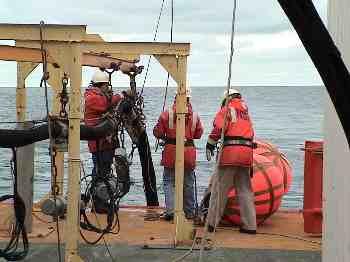24 January, 2004
The bergs and sea ice that we had grown accustomed to became a thing
of the past today as we changed course to work in the Ross Sea east
of B15A. The ice maps for that area showed clear water, which would
make it mach easier to deploy the seismic streamer. We headed north
then east until we were in the open water of the Ross Sea. We would
start the day doing a multi beam survey for most of the morning, with
the plan to deploy the multichannel seismic streamer in the afternoon.
At 12:50 in the afternoon the fire and emergency signal was sounded.
A fire or emergency is signaled with a continuous blast of the ships
whistle and continuous ringing of the general alarm bells. All crew
must report to their emergency stations and all remaining hands must
head to the 03-conference room for briefing with emergency gear.
Many of the science and marine support were in bed, and were a bit
groggy as they made their way to the conference room.
In the halls we could hear announcements being made to the fire
fighters that there was a fire in the front electronics area in the
dry lab. This is the area where we have station watch and where all
the equipment for the seismic and multibeam is kept. At this point,
no one was sure what was going on; we just went to the 03-conference
room as quickly as possible.
When we arrived, Ashley Lowe had a logbook out for everyone to sign
in. She also began to take roll from the room lists. After everyone
had checked in the Chief Mate came to the conference room to explain
that this was a drill and their intention was to make sure everyone
new to the ship knew where to go and to test the preparedness of the
fire team. Since the fire had been described as being in an
electronics area, they wanted to makes sure that the firemen would
choose carbon dioxide over water to fight a fire. The crew on the
ship is always preparing for any emergency that might occur. The
safety of all persons on board is primary to the captain and crew.
By late afternoon the marine techs would deploy the streamer to begin
taking seismic data again. With the large span of open water, we
would be taking much longer shot lines than we had been able to
previously. The marine techs were very careful and diligent as they
deployed the air guns. Each gun is about a meter long and made of
heavy metal. They can be very awkward, as they are taken off the
trolley, so great care is taken to insure that everyone helping knows
what parts of the gun array are being hoisted off. As the array is
being lowered off the back deck, buoys are attached to keep the guns
positioned a fixed depth below the water as they are pulled behind
the ship.
The ship travels at a speed of about 4.5 knots when doing seismic.
When we are doing just multibeam sidescan sonar, the ship operates at
about 10 knots. It takes more time to cover the same amount of area
doing seismic. This would be the start of at least two days towing
the streamer.

Deploying the gun array. Attaching buoys and slowly lowering it over the back deck.

Ice map showing the area of open water north and east of B15A. Ship track to date is shown in red.

Air gun hanging from the gun array.

Contact the TEA in the field at
.
If you cannot connect through your browser, copy the
TEA's e-mail address in the "To:" line of
your favorite e-mail package.
|
